

Cleveland Browns
Oscar Roan
South Oak Cliff (SOC)
High School in Dallas, Texas served a Caucasian community from its opening
in 1952 through 1965. As one of the largest public high schools in Dallas,
it had more than its share of gifted athletes including NFL quarterbacks
Karl Sweetan and Mike Livingston. Livingston was typical in that many SOC
football players remained in Dallas and played college football at Southern
Methodist University. As the area junior high schools that fed SOC changed
and were classified by the State of Texas as “Negro schools,” SOC underwent
a rapid change in its student population. Mandated integration began in 1966
and what had been a school attended by a student body that was one hundred
percent white, had by 1970, become one that was one hundred percent African
American. The great athletic tradition remained however and many of the
school’s most talented gridiron heroes like Wayne Morris and Ricky Wesson,
as had their white counterparts before them, continued to matriculate at
SMU. One of the most gifted SOC athletes, Oscar Roan, class of 1970,
excelled not only in football but in baseball, basketball, and track. He
chose to utilize his 6’6” frame and All-District talent in all four sports,
as part of John Wooden’s storied basketball program at UCLA, joining Bill
Walton and five other High School All Americans on that team.
The tough inner-city youth
decided to pursue both football and basketball at UCLA. Oscar received a great
deal of playing time even as the seventh man on the Bruins freshman team,
one that was obviously going to be of championship caliber for years to come.
However, he realized that California was not his best choice and after Bruins
head football coach Tommy Prothro departed to lead the Los Angeles Rams, he
decided to return home to Dallas. He was immediately welcomed to the SMU
athletic program where he joined a number of his high school teammates. His
talent was immense and it appeared that his varsity career would be punctuated
by a bushel of receiving records. A coaching change prior to his junior season
however, brought in Dave Smith, a former SMU assistant who had been successful
in the CFL and in his one season as head coach at Oklahoma State. Of course no
one could have known at the time of his arrival in Dallas that Smith’s
recruiting indiscretions at OSU would lead to NCAA penalties in Stillwater or of
the illegal activities to come at SMU.
For a receiver like Roan, the
offensive scheme saddled him with little use for his soft hands, leaping
ability, and fluid athletic grace as the Mustangs switched to a grind it out
Wishbone offense. Still, his talent was so great that playing with former high
school teammate Wesson who commanded the Mustangs attack as their first starting
African American quarterback, he earned Second Team All Southwest Conference
honors and his return to the basketball court for SMU’s ’73 season was pivotal
to their success. Star of that hardwood team, Ira Terrell stated that Roan’s
presence in the only year he played basketball for SMU, provided the catalyst
for the squad’s success. “He just kind of solidified everything, I didn’t have
to always guard the best post man or the big-time scorer. He could do that… He
was one of those guys that didn’t need the ball. Most guys need the ball.”
Though he was the conference Newcomer Of The Year, Oscar chose to focus
exclusively on football for the remainder of his college career.
An unselfish athlete, Roan
was named Consensus All SWC after his senior season, primary for his excellent
blocking ability, as his team leading nineteen pass receptions and four
touchdowns certainly were not worthy of widespread recognition. His blocking
talent leap-frogged his name onto the All American Blocking Team. Still his
speed, muscular 215 pounds, and obvious athletic ability made him the Cleveland
Browns third round draft choice and the team’s second pick for 1975. His
professional career got off to a fine start as Roan beat out incumbent tight end
Milt Morin and hauled in forty-one passes for 463 yards and three touchdowns.
Even Morin raved about his new teammate, despite being beaten out by Oscar for
the starting position. Morin stated, “In concentration, over-all knowledge, and
playing poise, Oscar is a couple years ahead of me when I came into the league.
He didn’t play or handle himself like a rookie. There are things he can do that
I never could have done at that age. He’s dedicated, he wants to be the best and
I admire him for it.” Holding the starting position into the 1976 season,
Roan’s production dropped as the Browns’ quarterback situation was in flux due
to injury at that position. His own injuries also began to take a toll in only
his second season and were a significant limiting factor by ‘77. A coaching
change for that ’77 season saw Sam Rutigliano come in and Forest Gregg leave. In
conjunction with a hip pointer and hyperextended knee, what was proving to be a
chronic wrist problem further hampered Oscar’s contributions and by the end of
1978 his professional career was over.
(game worn)
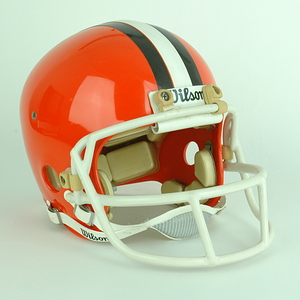
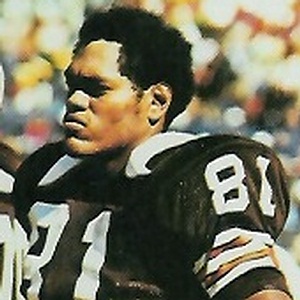
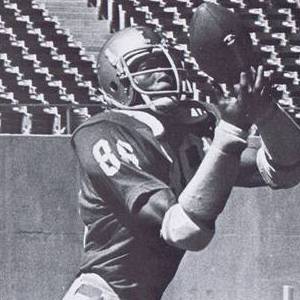
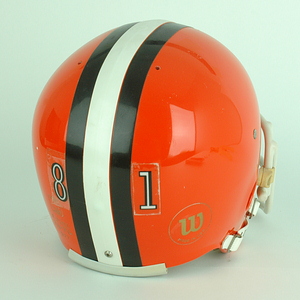
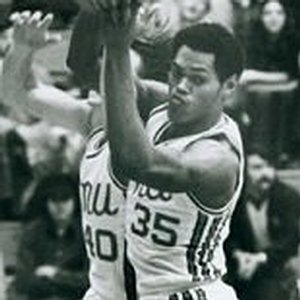
Unlike so many others
however, while his football status was diminished, Oscar Roan’s personal
journey had brought tremendous growth. Though he had spent his off seasons
as a credit analyst in the banking industry, he had given his life over to
Christ while in college. Oscar had been involved with ongoing work within
the Fellowship Of Christian Athletes and by the time of his football
retirement he became the full time director for the Dallas Chapter of the
FCA. Oscar and his wife Linda have spent the past decades serving a variety
of Christian ministries, teaching, and guiding workshops in the name of
their religious beliefs. While many may have forgotten Oscar Roan as a tight
end of the Cleveland Browns, he remains a well known and highly respected
name within the Christian community. This of course gives Roan distinction
and though his time with the Browns was limited, his choice of helmet also
gave him distinction. Close observation of the Browns standard orange
headgear with white center stripe and seal brown flanking stripes shows that
Mr. Roan did not wear a standard issue Riddell model but instead, favored
the Wilson F2101 with the Browns white facemask that they had switched to
for the 1975 season. The F2101 featured Wilson’s Velcro attached Isosorb
Helmet System which was a series of closed-cell foam compartments that were
pre-filled with air. Roan’s helmet shows unique characteristics and the same
could be said for the successful, articulate, and charismatic Mr. Roan.